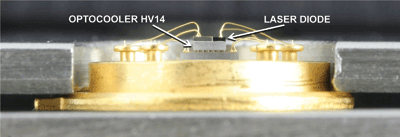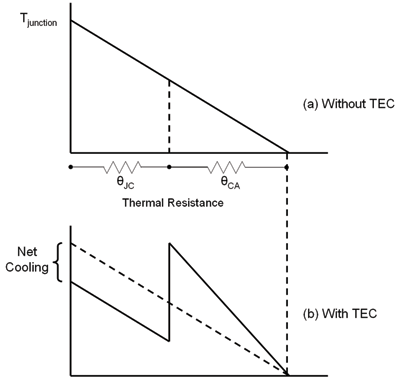Thin-film thermoelectrics cool optoelectronics
Thin-film TECs improve product performance and lifetime due to their speed and ability to pump large amounts of heat
BY DAVE KOESTER
Nextreme Thermal Solutions
Durham, NC
http://www.nextreme.com
Optoelectronic components have long had to deal with thermal management issues in order to ensure proper device performance. These range from temperature stabilization for transmission sources to low temperature cooling for detectors. To deal with these issues, the telecom industry has employed active thermal management solutions based on thermoelectric devices, commonly called TECs (thermoelectric coolers). In the optoelectronic industry, as with most other industries, the push is for constantly smaller form factors, and in the case of TECs, faster response times.
In addition to smaller packaging and higher heat densities, the junction temperature of laser diodes can directly affect the performance and longevity of devices. As the junction temperature rises, a significant loss of power output (luminosity) occurs.
Temp control with TECs
TECs are solid-state heat pumps that operate using the Peltier effect. When an electric current is driven through a circuit containing two dissimilar materials, heat is absorbed at one junction (the cold side) and released at the other junction (the hot side).
The design of most Peltier devices requires the use of both an n-type semiconductor and a p-type semiconductor. Since heat naturally flows down a temperature gradient from hot to cold, a TEC’s ability to move heat from cold to hot in a solid-state fashion is unique.
By reversing the polarity of the applied dc current, heating is also possible. This property is especially useful for applications requiring both cooling and heating for precise temperature control.
Conventional TEC solutions (sometimes referred to as bulk TECs) have been used for years to control the temperature of optoelectronics. However, conventional bulk thermoelectric technology has not kept pace with the changing size and power density needs of new applications.
In some instances, designers choose to place the cooling device outside the package if it is too large to be inside. Cooling the entire package is at best inefficient for thermal management and often leads to oversizing the TEC that needs more drive power and leads to more waste heat in the system.
Advantages of thin-film TECs
A relatively new development is the manufacture of thin-film TECs, which use semiconductor-processing techniques to create a nanostructured thin film for the p and n legs. Thin-film TECs are typically 5 to 20 µm thick, versus 200 µm for the thinnest pellets in bulk TECs, resulting in several differences.
Heat flux, which is inversely proportional to the thickness of the thermoelectric material, is 20+ times greater than bulk TECs. Thin-film TECs pump a maximum heat flux of 100 to 400 W/cm2 versus less than 15 W/cm2 for typical bulk TECs.
Thin-film TECs can operate in a high coefficient of performance (COP) regime and still pump a reasonably high heat flux (20 to 40 W/cm2 ). COP is a measure of efficiency defined as cooling power divided by input power.
Depending on the design, thin-film TECs may have thermal response times as low as milliseconds enabling very rapid cooling and heating to maintain precise temperature control. They are known to have higher heat-pumping capability than standard bulk TECs, but for temperature control applications, the superior switching speed of the devices may ultimately prove to be their most valuable asset.
Example
To illustrate the benefits of controlling the temperature of an optoelectronic device using a thin-film TEC, a 1,310-nm Fabry-Perot laser diode was mounted on the active side of a thin-film OptoCooler HV14 thermoelectric module in a TO-8 package. At 85°C, the HV14 module operates at a maximum of 2.7 V and can pump 1.5 W of heat in a footprint of 3 mm2 .
The module can create a temperature differential (∆T) of up to 50°C between its hot and cold sides, suiting it well for the temperature control of optoelectronic devices such as laser diodes. Due to its low mass, the OptoCooler HV14 can respond to changes in operating current in
Figure 1 shows the TEC embedded inside the package. The TEC was thermally coupled to the chip and TO base. A thermistor was installed to measure the temperature of the active side of the TEC.

Fig. 1. Side profile of a laser diode TO package (cap removed) with embedded OptoCooler HV14 TEC.
With a testbed consisting of a power meter, temperature controller, laser diode controller, and optical spectrum analyzer, we measured the effects of temperature on laser output and spectra. The drive current for the laser diode was set to 100 mA and the TEC was cycled on and off.
With the TEC turned off, the temperature of the laser diode rose to 42°C with an output of 0.416 mW. With the TEC turned on, the temperature decreased to about 21°C and the output level of the laser diode nearly doubled to 0.755 mW. The optical spectrum analyzer measured a wavelength shift of approximately 13.6 nm (see Fig. 2) .

Fig. 2. Spectra comparison of cooling effect.
System-level considerations
The TEC, being an active thermal device, creates a thermal inversion that dramatically changes the thermal profile inside the package. Figure 3 shows a comparison of the thermal profile through the cross section of the module in two cases: (a) with no TEC (a passive solution only) and (b) with a TEC actively cooling the junction. It can be clearly seen that the introduction of the TEC provides a substantial net cooling benefit.

Fig. 3. Temperature profiles through the cross section of a package from the junction to the case (θJC), and case to ambient (θCA) without (a) and with (b) a TEC. The temperature inversion created by the TEC lowers the junction temperature relative to the no-TEC case.
The heat pumped by the device and the extra heat created by the TEC in the course of pumping that heat must be rejected into the system. Since the performance of the module can be improved by providing a good thermal path for the rejected heat, it is beneficial to provide high thermally conductive pathways. For small TO packages, this is typically accomplished through the electrical connections themselves, and depending on the operating characteristics, this level of thermal management might be sufficient. For packages with higher heat densities, thermally conductive feedthroughs or posts may be needed to remove the heat. ■
Advertisement
Learn more about Nextreme





